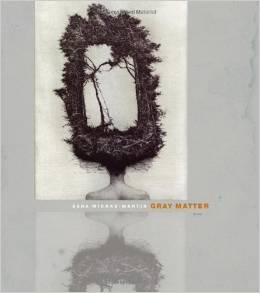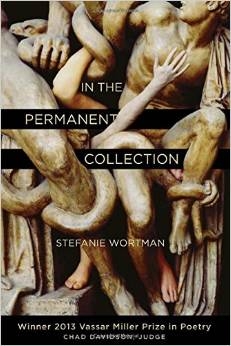

 Critics of American poetry tend to invoke certain binaries as a way to make sense of the vast and diverse body of poetry in this country: Dickinson versus Whitman, for example, or modern versus postmodern, or lyric as opposed to narrative. All of these oppositions are to some extent reductive, but nonetheless helpful in locating the dominant traditions in our poetry and in tracking the influence of those traditions over time. If the three poets – Sarah Michas-Martin, Stefanie Wortman, and John Repp – whose work I discuss here are representative of our contemporary poetic moment—and I think they are—one binary we might invoke to help think both about their writing and about contemporary poetry writ large is that oft-cited odd couple, Wallace Stevens and William Carlos Williams.
Critics of American poetry tend to invoke certain binaries as a way to make sense of the vast and diverse body of poetry in this country: Dickinson versus Whitman, for example, or modern versus postmodern, or lyric as opposed to narrative. All of these oppositions are to some extent reductive, but nonetheless helpful in locating the dominant traditions in our poetry and in tracking the influence of those traditions over time. If the three poets – Sarah Michas-Martin, Stefanie Wortman, and John Repp – whose work I discuss here are representative of our contemporary poetic moment—and I think they are—one binary we might invoke to help think both about their writing and about contemporary poetry writ large is that oft-cited odd couple, Wallace Stevens and William Carlos Williams.
The poet of imagination, of interiority and abstraction, Stevens can be understood as a kind of foil to Williams, the poet of things, of exteriority and concreteness. And while it’s true that almost all contemporary poetry can, in some way, be located between these two ostensible extremes, I begin with this rather wide-angle, meta-critical discussion because this question of how poetry orders or categorizes the world around it is explored both formally and thematically by each of the three writers under review here. These writers, then, are direct inheritors of the Stevensian legacy, invested in the poetic mind encountering, ordering, and transforming material reality. These books aren’t interested in mimesis, but rather in holding a mirror up to their own poetic activity.
I invoke both Stevens and Williams, though, because these three poets also retain the latter’s fierce insistence on the primacy of the material world, of things. Indeed, in all three books, the catalog form itself functions to varying degrees as a kind of commentary on the relation between poetry and material reality. In their use of the catalog, these poets echo and adapt the form’s traditional use as a suggestion of vastness—of battles and ships in antiquity, for example—or to itemize beauty, as in the Renaissance blason, or to demonstrate the unity of a seemingly heterogeneous world, as in Whitman.
It’s this last use of the catalog that seems most central to Sara Michas-Martin’s Gray Matter, the opening lines of which address the self as a heterogeneous multitude in a sea of others: “Hello internal assembly team,” Michas-Martin writes in “Illusion of One,” “I am un-singular today in this rash of faces.” If reality is for Michas-Martin a variegated collection of matter, then perception, like poetry, is the effort to catalog this matter, an act of assembling in one place the fragments of reality and of ordering those fragments into a whole. Describing this process, Michas-Martin writes:
you might say the body
is awash with industry the mind
bears down to evolve to weed through
the intake whole sequences.
The self, then, insofar as it exists through perception, exists as a Sears-like catalog of the material world, and memory is the act of flipping its pages. “The mind rallies its fragments,” Michas-Martin writes in “In Sleep the Brain Retrieves a Snake”:
my sister
a Safeway stock boy
my car an empty television box.
And recently
the return of the snake
sliding through my house, a lean-to
made of cambio receipts
and not in Arizona but in Maine
on a beach in the off season.
As in this poem, memory—a chemical and electrical process that seems nonetheless to retain some numinous quality beyond the material—is central to Gray Matter as a whole. Residing in the literal gray matter of our brains, memory occupies that mysterious gray area between matter and spirit, according to Michas-Martin. “When she passed,” she writes of a childhood friend, “songs we learned with God in the chorus / stopped living in her brain.” The passage is a deft and moving objective correlative for a scientific problem that reaches back to Locke and, before him, to Plato and Aristotle—namely the problem of where in the process of perception materiality ends and what we think of as the “spirit” of the self begins.
A former Stegner Fellow and Jones Lecturer at Stanford University, Michas-Martin is at her best when she shows how the associative leaps of memory correspond to those of poetry. Both memory and language, that is, mediate between the spiritual and the material, so that the poem, like the mind, holds together and attempts to order a diverse set of material phenomena. The poem “Olfaction,” for example, one of the strongest in the collection, begins with a description of the smells of garbage and cigarette smoke drifting into the speaker’s apartment. It moves next into a daydream about trout on Lake Michigan, followed by a meditation on evolution:
some shared design of early human before our creature
staggered out of the ocean breathing on half-formed lungs
testing new measures of gravity brain sprouting
around the olfactory bulb.
Finally, “the smell of chlorine [ . . . ] which lives / where memory lives” prompts the speaker to recall the swim meets of her childhood, completing a tightly linked associative chain held together, in Proustian fashion, by the biological link between scent and memory.
Gray Matter is less successful when those linkages remain unclear, when its images seem more dissociative than associative. While such incoherence might be mimetic of the actual processes of memory and perception—which sometimes don’t, of course, cohere into meaning—it’s dissatisfying in a presumably well-wrought work of art. And while Michas-Martin, like Stevens, sometimes relies too heavily on abstraction, her best work employs vibrant and precise imagery to explore, in a concrete way, complex cognitive processes; it’s a testament to this poet’s craft that this collection, her first, renders those processes in such stark and evocative ways.
Stefanie Wortman’s debut book, In the Permanent Collection, suffers a similar tendency toward a kind of centrifugal failure to cohere, its poems sometimes crammed too full of collected material, though such abundance is perhaps fitting in a book with this one’s title. The book’s title poem, for example, might have been a tight, ekphrastic meditation on violence and aesthetic representation in a Laocoön sculpture had it not also, in the space of a dozen or so lines, mentioned “a more modest bit of sculpture / [ . . . ] two birds cast / in metal,” “some borrowed / Parisian lithographs,” and another Laocoön miniature in “the drain cover / set into floor tiles.” Once again, such diversity no doubt mirrors the reality of the unnamed museum in which the poem is set, but I would prefer a bit more order from poetry and that such a catalog would amount to a more profound statement than “The art in this fixture / is as weird to me as those ghosts of masterpieces / crowded into a room painted bluer than the sky could / ever be . . .”
If at times Wortman indulges in the same fault for which Johnson critiqued Donne, a “yoking together by violence” of widely disparate phenomena, In the Permanent Collection is most successful when it ties this formal violence to the violence of the world around it. The poem “Low Definition” is a good example:
A goalie’s throat bisected by a skate.
A pit bull accidentally shot in a drug raid.
Prince Ginger whom his comrades in war name
Bullet Catcher. A computer model of the blade
cutting through neck muscles. Cartilage
extracted by forceps, a piece of bone-sponge.
Blood slick on the ice. A police dredge
hauled through the riverside reed fringe.
These things I saw on TV. And next:
behind the urban prison’s display glass,
a guard with a moustache directs
a man to remove his navy work pants,
his briefs. Does his face betray humiliation?
The jail, too, was designed for observation.
Like Bentham’s Panopticon, to which this last line alludes, poetry for Wortman is a form of observation through glass, a cataloging of real and imagined violence that itself resorts to techniques of violence in order to make beauty. In the excellent poem “Compact Mirror,” Wortman describes the violence of the poetic gaze by addressing her mirror:
Thank you for this partitioning, for vision
that doesn’t force wholeness, unwilling
to look at the entire face, which defies our best
attempts to interpret it. A movie director
says the close-up shot always works
because we can’t get enough of looking
at human faces.
If poetry, like film, is a kind of violence undertaken in the name of beauty—involving, as film does, a cutting, a partitioning, a reordering—Wortman is aware of the risks and the limits in such a process. “Whether we fold” our loved ones “into a coffin, into a boxor, the poet suggests, into a poem—they are / not folded, are not there, are not.” Despite its attempts to catalog and memorialize the material world, the poetry of violence is, as she describes a photo of a French horn on the cover of a funeral program, always “trite and a little distasteful.” The passage is a funny one, and indeed much of In the Permanent Collection carefully employs humor to offset the seriousness of its meditations on violence; I don’t think any other poem has made me laugh as I did at the over-the-top apostrophe “To My Heart.”
Wortman’s language is playful not only in its humor and wit, but in its precise attention to sound, particularly in rhyme, alliteration, and assonance, all of which are active to just the right extent in this collection. A book in four sections, In the Permanent Collection is most successful when it dramatizes the process of making lyric out of cultural violence, less so when this lyricism is used to depict romantic love, which itself seems trite after poems about Hurricane Katrina, King Lear, capital punishment, and the Iraq war. That it seems so, however, suggests how intensely the poems of violence succeed in exploring, as did Stevens, the aesthetic violence of representation.
If the catalog form, as I’ve been suggesting, perpetually straddles the line between order and chaos, meaning and incoherence, John Repp’s Fat Jersey Blues takes as its subject precisely this failure to cohere, thematizing poetry’s inability to make sense of a haphazard material world. Throughout the collection, his fourth, Repp meticulously catalogs the material of our everyday lives, the “iceberg lettuce over the patty” and “tartar sauce on the side, / the little pleated cup chilled from its stay in the 1936 Frigidaire.” “A thing,” Repp says, echoing Williams, “is a joy forever,” and it’s precisely in things that Repp finds a momentary plenitude along the lines of what Lukács might call immanence, a fullness of meaning that exists irrespective of poetry’s “snooty need to fiddle & falsify.”
Fat Jersey Blues is an epicurean collection of material pleasures. “Then I eat,” Repp writes in “Ode to Didi’s Squash Stew & the Waitresses at Fred’s Place”:
existence a mouthful
of deep-fried dough, honey & stew, existence just
what the sages claim—ripe for devouring, poised to devour,
pollen, bee, sweetness & gone.
The beauty of such pleasure lies in its transience, just as the beauty of poetry, Repp suggests, lies in the passing pleasingness of sound, irrespective of whatever traditional “meaning” the ideas of the poem might point to. “Say blueberry,” Repp writes, echoing Hass perhaps a bit too closely, “Say it sound by sound.” And later: “Notice what your mouth does with peach. With Achilles. With sleep.”
Repp’s willingness to eschew more organized forms of meaning lends this book a wry, sardonic, devil-may-care tone that sometimes makes it difficult to take these poems seriously as philosophical and emotional investigations. The collection is often too offhand and colloquial, undercutting what might otherwise be the book’s strongest moments, when Repp approaches a profound sincerity. “Poetry teaches what life does, that neither is enough,” Repp writes quite powerfully, before undermining that statement in the next line: “The Russians can get away with sentences like that, / so I proclaim myself an honorary Futurist.” Repp seems to shrug his shoulders at what poetry can do—“Ah well,” he ends one poem—but the problem with invoking the uselessness of poetry is that one has written an entire book of poetry.
When Repp sets aside this glib pose, however, Fat Jersey Blues is a moving, melancholic archiving of the material of our lives before it vanishes—or, more appropriately, before we vanish. In this way, the collection echoes not only Williams’s careful cataloging of the material world, but Eliot’s effort in The Waste Land to find some kind of meaning in the detritus of history. “These fragments,” Eliot writes, “I have shored against my ruin.” In one of the book’s best poems, “What Happens to the Circus,” Repp echoes this mournful resignation: “The one circus I’ve witnessed / exists only in a crumbling poem / that says things I’d never say now,” an elegiac lament for the glory of the vanished past. “I love knowing / how people lived in the deep past,” Repp writes:
or at least the best, most detailed & vivid guess
about what they ate & celebrated & how.
We originated there somehow, the ancestors
dust eventually, but not for a long time.”
If Stevens and Williams are these three poets’ literary ancestors, they are perhaps themselves not yet dust, existing as they do still in these poets’ detailed and vivid meditations on the role and purpose of poetry in a world that is for us both self-like and terrifyingly other.


